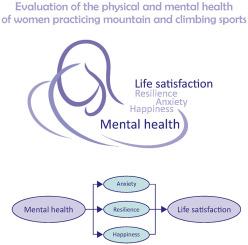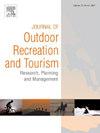女子山地运动与登山的心理健康研究:精英与非精英
IF 4.4
3区 管理学
Q1 HOSPITALITY, LEISURE, SPORT & TOURISM
Journal of Outdoor Recreation and Tourism-Research Planning and Management
Pub Date : 2025-09-26
DOI:10.1016/j.jort.2025.100961
引用次数: 0
摘要
目前社会对参加户外活动有兴趣,这就需要对这些运动周围的社会心理因素进行更深入的研究。这项建议是“评估从事登山运动的妇女的身心健康”项目的一部分。对参加这些运动的妇女的心理健康和社会心理变量进行了分析。本研究的目的是调查参与者的心理社会健康状况,并分析年龄和运动水平(精英与非精英)的影响。共有91名女性参加,分为两组:20名来自西班牙国家队(初级和高级)的攀岩、滑雪登山和山地跑步运动员(精英组)和71名非精英女性。采用西班牙主观幸福量表、生活满意度量表、短期弹性应对量表、DASS量表(抑郁和压力)和竞争状态焦虑量表。所有使用的量表都经过验证。不同年龄(35岁以下与35岁以上)在心理弹性方面存在显著差异[Z = 688, p = 0.007, Hedges的g = 0.702];抑郁[Z = 780, p = 0.05, Hedges' g = .452];应力[Z = 789, p = 0.05, Hedges' g = .442];认知焦虑(Z = 560, p & lt;措施,树篱的g = .863);躯体焦虑(Z = 758, p = 03,树篱的g = .453);和自信(Z = 688, p = .007树篱的g = .613]。在运动水平上,优秀运动员表现出更高的生活满意度[Z = 482, p = 0.028, Hedges' g = .559]和更低的认知焦虑[Z = 383, p = .002, Hedges' g = .841]。线性回归分析显示,这两个预测变量对主观幸福感方差的贡献率为57.7% (R = .785, R2 = .586, R2 = .577, F(2-88) = 62.307, p < 001,幂β-1 = .97783)。权重最大的变量是生活满意度(Beta = 0.582, t = 6.901, p < 0.001),其次是心理弹性(Beta = 0.263, t = 3.118, p = 0.002)。对研究结果的讨论表明,这项研究与其他类似的研究是一致的。该研究的一个潜在限制是样本量相对较小。本文章由计算机程序翻译,如有差异,请以英文原文为准。

Study on the mental health of women practicing mountain sports and climbing: elite vs. non-elite
There's current social interest in participating in outdoor activities, which necessitates a deeper examination of the psychosocial factors surrounding these sports. This proposal is part of the project "Evaluation of the physical and mental health of women practicing mountain and climbing sports". Mental health and psychosocial variables are analyzed in women who participate in these sports. The purpose of the study is to investigate the psychosocial well-being of the participants and to analyze the effect of age and sporting level (elite vs. non-elite). A total of 91 women participated, divided into two groups: 20 athletes from the Spanish national teams (junior and senior) in climbing, ski mountaineering, and mountain running (elite group), and 71 non-elite women. The following scales were used: the Spanish Subjective Happiness Scale Satisfaction with Life Scale, Brief Resilient Coping Scale, DASS Scale (for depression and stress), and the Competitive State Anxiety Inventory. All scales employed are validated. Significant differences were found by age (under 35 years vs. over 35 years) in resilience [Z = 688, p = .007, Hedges' g = .702]; depression [Z = 780, p = .05, Hedges' g = .452]; stress [Z = 789, p = .05, Hedges' g = .442]; cognitive anxiety [Z = 560, p < .001, Hedges' g = .863]; somatic anxiety [Z = 758, p = .03, Hedges' g = .453]; and self-confidence [Z = 688, p = .007, Hedges' g = .613]. By sporting level (elite vs. non-elite), elite athletes exhibited greater life satisfaction [Z = 482, p = .028, Hedges' g = .559] and lower cognitive anxiety [Z = 383, p = .002, Hedges' g = .841]. The linear regression analysis revealed that the two predictor variables accounted for 57.7 % of the variance in subjective happiness (R = .785, R2 = .586, R2 = .577, F(2–88) = 62.307, p < .001, power β-1 = .97783). The variable with the greatest weight was life satisfaction (Beta = .582, t = 6.901, p < .001), followed by resilience (Beta = .263, t = 3.118, p = .002). The discussion of the study's findings demonstrates that this research is consistent with other similar investigations. A potential limitation of the study is the relatively small sample size.
求助全文
通过发布文献求助,成功后即可免费获取论文全文。
去求助
来源期刊

Journal of Outdoor Recreation and Tourism-Research Planning and Management
HOSPITALITY, LEISURE, SPORT & TOURISM-
CiteScore
6.70
自引率
5.30%
发文量
84
期刊介绍:
Journal of Outdoor Recreation and Tourism offers a dedicated outlet for research relevant to social sciences and natural resources. The journal publishes peer reviewed original research on all aspects of outdoor recreation planning and management, covering the entire spectrum of settings from wilderness to urban outdoor recreation opportunities. It also focuses on new products and findings in nature based tourism and park management. JORT is an interdisciplinary and transdisciplinary journal, articles may focus on any aspect of theory, method, or concept of outdoor recreation research, planning or management, and interdisciplinary work is especially welcome, and may be of a theoretical and/or a case study nature. Depending on the topic of investigation, articles may be positioned within one academic discipline, or draw from several disciplines in an integrative manner, with overarching relevance to social sciences and natural resources. JORT is international in scope and attracts scholars from all reaches of the world to facilitate the exchange of ideas. As such, the journal enhances understanding of scientific knowledge, empirical results, and practitioners'' needs. Therefore in JORT each article is accompanied by an executive summary, written by the editors or authors, highlighting the planning and management relevant aspects of the article.
 求助内容:
求助内容: 应助结果提醒方式:
应助结果提醒方式:


